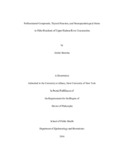Please use this identifier to cite or link to this item:
http://archive.nnl.gov.np:8080/handle/123456789/409| Title: | Perfluorinated compounds, thyroid function, and neuropsychological status in older residents of Upper Hudson river communities |
| Authors: | Shrestha, Srishti |
| Keywords: | Perfluorinated compounds Thyroid Neuropsychological status Thyroid hormones |
| Issue Date: | 21-Dec-2017 |
| Abstract: | Perfluorinated compounds (PFCs) are widespread in the environment. Minimal data exist regarding the neurotoxicity and thyroid disruptive property of PFCs in aging populations and the possible mediating effects of thyroid hormones (THs). In this study, we assessed associations among PFCs, thyroid function, and neuropsychological status, and determined if the neurotoxic effects of PFCs are mediated by changes in THs in an aging population. We measured perfluorooctanoic acid (PFOA), perfluorooctane sulfonate (PFOS), thyroid stimulating hormone (TSH), total thyroxine (T4), free T4 (fT4), and total triiodothyronine (T3) in serum and performed neuropsychological tests in men and women aged 55-74 years and living in upper Hudson River communities. Multivariable linear and quantile regressions were conducted. Mediation analyses were performed to obtain thyroid-mediated, non-thyroid, and total effects of a PFC on a neuropsychological test score. Geometric means (standard deviations) of serum PFOS and PFOA were 34.20 (1.80) ng/mL and 8.10 (1.72) ng/mL respectively, higher than the levels in the general U.S. population. Serum PFOS was positively associated with fT4 and T4 in the overall study sample; one interquartile range increase in PFOS was associated with 5% and 9% increases in fT4 and T4 respectively. The results also suggested statistical interaction between PFOA and age for the effects on fT4 and T4. Associations between THs and neuropsychological function were domainspecific. Higher T4 and fT4 were associated with improved visuospatial function, as measured by Block Design Subtest (BDT) total scores, in the overall study sample. We detected statistical interactions between age and THs for effects in tasks of memory and learning and executive function. Concurrent increases in age and THs were associated with deficits in memory and learning and executive function. We detected protective effects of PFCs in tasks of memory and learning and executive function. Total thyroxine partially mediated the protective effect of PFOS on BDT total scores (proportion mediated = 51%). However, the protective effects of PFCs on memory, learning and executive function were mostly mediated via pathways other than those involving alterations in THs. These findings provide insight regarding the impact of PFCs on thyroid and neuropsychological function and the role of THs. |
| Description: | A Dissertation submitted to the University at Albany, State University of New York in partial fulfillment of the requirements for the Degree of Doctor of Philosophy, School of Public Health, Department of Epidemiology and Biostatistics, 2014. |
| URI: | http://103.69.125.248:8080/xmlui/handle/123456789/409 |
| Appears in Collections: | 600 Technology (Applied sciences) |
Files in This Item:
| File | Description | Size | Format | |
|---|---|---|---|---|
| Dissertation_Shrestha_Srishti_For Nepal.pdf | 1.6 MB | Adobe PDF |  View/Open |
Items in DSpace are protected by copyright, with all rights reserved, unless otherwise indicated.